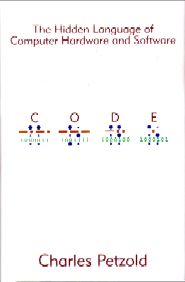
Title: Code: The Hidden Language of Computer Hardware and Software
Author: Charles Petzold
Genre: Technology
Trigger Warnings: None
Back Cover:
What do flashlights, the British invasion, black cats, and seesaws have to do with computers? In CODE, they show us the ingenious ways we manipulate language and invent new means of communicating with each other. And through CODE, we see how this ingenuity and our very human compulsion to communicate have driven the technological innovations of the past two centuries.
Using everyday objects and familiar language systems such as Braille and Morse code, author Charles Petzold weaves an illuminating narrative for anyone who’s ever wondered about the secret inner life of computers and other smart machines.
It’s a cleverly illustrated and eminently comprehensible story—and along the way, you’ll discover you’ve gained a real context for understanding today’s world of PCs, digital media, and the Internet. No matter what your level of technical savvy, CODE will charm you—and perhaps even awaken the technophile within.
Review:
This is not the kind of book I would normally read. But I found a free PDF of it somewhere online, put it in Evernote to read someday, and started it because I’m at my new job for 5 hours every day and I have about 1.5 hours of work per day.
Code is an interesting book. It takes you through the technology from the telegraph to the computer, and explains a lot of concepts in the meantime. Reading it was the first time I felt like I actually understood Boolean algebra or non-base-10 numbering systems like base-8, base-12, and even binary (base-2).
On the other hand, computers are complicated. I’ll admit that the part where he explained how computers use circuits to store information and read it back out went way over my head. If you don’t have an extremely mathematical, mechanical, or engineering mind, it might not be a bad idea to have an engineer or computer expert on hand to explain some of this stuff to you.
This book is a little outdated – copyrighted in 2000 – and doesn’t cover a lot of newer technological advances like smartphones or even the video capabilities of computers. (Towards the end, Charles mentions that videos displayed on computers are poor quality and jumpy.) It’s a good book to understand how computers exist, how coding works, and the way electrical currents can store things as complicated as text and images, but you’re not going to get anything about the sheer power of modern computing.
This is a short review because I really don’t have a lot to say about this book. It was interesting. I learned a lot. Some of it was complicated and I really didn’t understand, even though Charles did his best to put it in simple English. Code was interesting and useful, but there wasn’t anything really spectacular about it.
